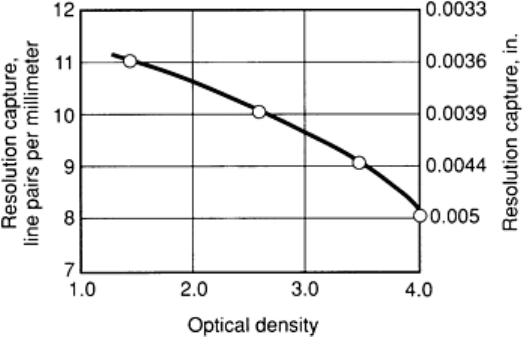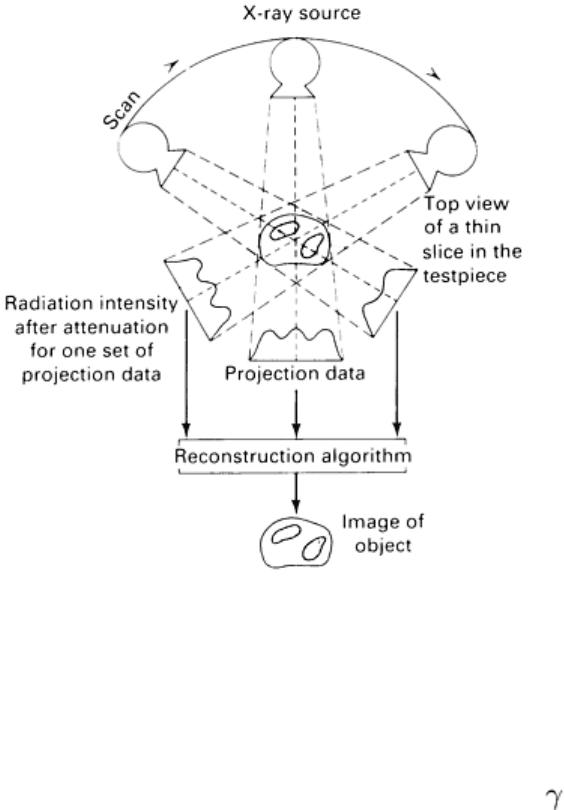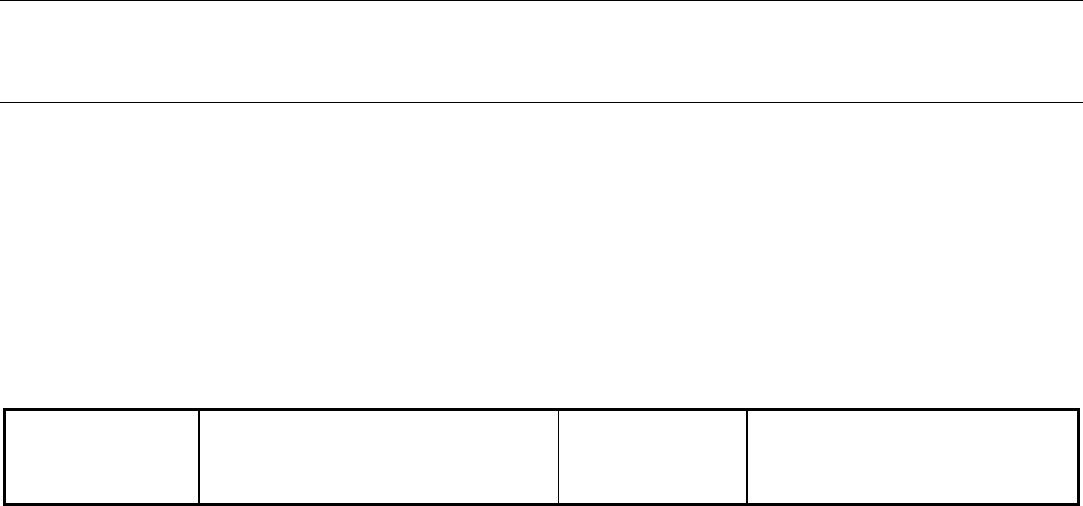ASM Metals HandBook Vol. 17 - Nondestructive Evaluation and Quality Control
Подождите немного. Документ загружается.


• Inadequate replenishment of chemicals (developer and fixer in particular)
• Failure to maintain processing temperatures within manufacturer's specified ranges
• Inadequate agitation
• Rushing processing times
• Failure to maintain water quality
The consequences can be failure to remove thiosulfate, resulting in a green, yellow, amber, or brown tint or image
destruction, and failure to remove uncombined silver resulting in general darkening of the image.
Examples of poor storage and handling practices include:
•
Handling radiographs without the use of gloves to protect the film from acids, chemicals, and
perspiration on the hands
• Placing rubber bands or paper clips on the film
• Storing hard copy information produced using a diazo process with film
• Stacking film, especially film not interleaved, causing it to adhere
• Filing wet film
• Placing inventory or acceptance punches in the area of interest
• Failure to store the radiographs in low-humidity/room-temperature conditions
• Failure to store radiographs in acid-free interleaving paper
The microfilming of radiographs has been used to transfer the deteriorated or degraded image to a stable, archival
medium. Microfilming is performed using a planetary camera system with illuminators to photograph the radiographic
image on 35 mm roll format. Spatial resolutions in excess of 120 line pairs per millimeter (or <0.0003 in.) on the resulting
image have been produced. With a reduction factor of 15:1, information on the original radiograph in the range of 8 line
pairs per millimeter (or a resolution of 0.005 in.) has been reproduced within a density of 4.0 (Fig. 69), and spatial
resolutions as high as 11 lines per millimeter (0.0035 in.) have been produced at lower densities.
Fig. 69
Spatial resolution versus optical density for a microfilm (15:1 reduction) of a radiograph with a spatial
resolution in the range of 8 line pairs per millimeter (or 0.005 in. resolution)
Because of the wide range of optical densities associated with industrial radiographs and the inability of high-resolution
microfilms to reproduce wide latitudes of density, the microfilming of radiographs may involve one or more exposures of
the same radiograph to capture all of the information present. Sensitometry checks of the process result in density capture
ranges (accurate contrast reproduction) as high as 1.5 density points per exposure.

Special viewing equipment is necessary for use with the microfilm. Equipment is available that will allow accurate
dimensional measurements from the microfilm, density determination, binocular viewing, and adjustable light intensities,
as with a typical radiograph viewer.
Radiographic Inspection
Revised by the ASM Committee on Radiographic Inspection
*
References
1. Radiography & Radiation Testing, Vol 3, 2nd ed., Nondestructive Testing Handbook,
American Society for
Nondestructive Testing, 1985
2. R. Halmshaw, Nondestructive Testing, Edward Arnold Publishers, 1987
3. R. Link, W. Nuding, and K. Sauerwein, Br. J. Non-Destr. Test., Vol 26, 1984, p 291-295
4. L.H. Brixner, Mater. Chem. Phys., Vol 16, 1987, p 253-281
5. W. Daum, P. Rose, H. Heidt, and J.H. Builtjes, Br. J. Non-Destr. Test., Vol 29, 1987, p 79-82
6.
"Nondestructive Testing Personnel Qualification and Certification, Supplement A, Radiographic Testing
Method," ASNT-TC-1A, American Society for Nondestructive Testing
Radiographic Inspection
Revised by the ASM Committee on Radiographic Inspection
*
Selected References
• H. Cember, Introduction to Health Physics, 2nd ed., Pergamon Press, 1983
• R.V. Ely, Microfocal Radiography, Academic Press, 1980
• D.A. Garrett and D.A. Bracher, Ed., Real Time Radiologic Imaging,
STP 716, American Society for Testing
and Materials, 1980
• "General Safety Standard for Installations Using Non-Medical X-Ray and Sealed Gamma-
Ray Sources,
Energies up to 10 MeV," ANSI N43.3 (Handbook 114), American National Standards Institute, New York
• R. Halmshaw, Industrial Radiology: Theory and Practice, Applied Science, 1982
• Handbook on Radiographic Apparatus and Techniques,
2nd ed., International Institute of Welding, London,
1973
•
"Industrial Radiographic Terminology," E 52, Annual Book of ASTM Standards, American Society for
Testing and Materials
• Industrial Radiography, Agfa-Gevaert Handbook (revised edition), Mortsel, 1986
•
"Instrumentation and Monitoring Methods for Radiation Protection," Report 57, National Council on
Radiation Protection and Measurements, 1978
• G.F. Knoll, Radiation Detection and Measurement, John Wiley & Sons, 1979
•
"Metallography and Nondestructive Testing," Volume 03.03 of Section 3, Metals Test Methods and
Analytical Procedures, Annual Book of ASTM Standards, American Society for Testing and Materials
• Methods for Radiographic Examination of Fusion-Welded Butt-Joints in Steel,
BS 2600, Parts 1, 2, British
Standards Institute, London, 1983
• Methods for Radiographic Examination of Fusion-Welded Circumferential Butt-Joints in Steel Pipes,
BS
2910, British Standards Institute, London, 1985
• Methods for Radiography and Classification for Steel Welds,
JIS/Z3104, Japanese Standards Association,
Tokyo, 1968
• K.Z. Morgan and J.E. Turner, Principles of Radiation Protection, John Wiley & Sons, 1973
• "Nondestructive Testing Pe
rsonnel Qualification and Certification, Supplement A, Radiographic Testing
Method," ASNT-TC-1A, American Society for Nondestructive Testing
• "Nondestructive Testing: Radiography," Report DDC-TAS-71-54-1, Defense Documentation Center, AD-
733860, 1971
•
"Performance Specifications for Direct Reading and Indirect Reading Pocket Dosimeters for X and Gamma
Radiation," ANSI-N13.5, American National Standards Institute, 1972
• Personnel Dosimetry Systems for External Radiation Exposures, Technical Report Seri
es No. 109,
International Atomic Energy Agency, 1970
• "Radiation Protection Design Guidelines for 0.1-
100 MeV Particle Accelerator Facilities," Report 51,
National Council on Radiation Protection and Measurements, 1977
• "Radiation Protection Instrumentation Test and Calibration," ANSI-
N323, American National Standards
Institute, 1978
• Radiography & Radiation Testing, Vol 3, 2nd ed., Nondestructive Testing Handbook,
American Society for
Nondestructive Testing, 1985
• "Recommendations on Limits for Exp
osure to Ionizing Radiation," Report 91 (supersedes Report 39),
National Council on Radiation Protection and Measurements, Bethesda, Maryland
•
Recommended Practice for the Radiographic Examination of Fusion Butt-Welds in Steel Plates from 0.5-
50
mm Thick, IIS/IIW-432-73, International Institute of Welding, London, 1973
• Specification for Image Quality Indicators for Radiography and Recommendations for Their Use,
BS 3971,
British Standards Institute, London, 1980
• "Standards for Protection Against Radi
ation," Code of Federal Regulations, Title 10 (Energy) Part 20, U.S.
Government Printing Office
• Testing of Welds of Metallic Materials by X- or Gamma-Rays,
DIN 54 111, Deutches Institut für Normung,
Berlin, 1973

Industrial Computed Tomography
Michael J. Dennis, General Electric Company, NDE Systems and Services
Introduction
COMPUTED TOMOGRAPHY (CT), in a general sense, is an imaging technique that generates an image of a thin, cross-
sectional slice of a testpiece (Fig. 1a). The CT imaging technique differs from other imaging methods in that the energy
beam and the detector array in CT systems lie in the same plane as the surface being imaged. This is unlike typical
imaging techniques, in which the energy beam path is perpendicular to the surface being imaged. Moreover, because the
plane of a CT image is parallel with the energy beam and detector scan path, CT systems require a computing procedure
to calculate, locate, and display the point-by-point relative attenuation of the energy beam passing through the structures
within the thin, cross-sectional slice of the testpiece.
Fig. 1 Comparison of computed tomography (a) and radiography (b). A high-
quality digital radiograph (b) of a
solid rocket motor igniter
shows a serious flaw in a carefully oriented tangential shot. A CT image (a) at the
height of the flaw shows the flaw in more detail and in a form an inexperienced viewer can readily recognize.
Courtesy of J.H. Stanley, ARACOR
Computed tomography has been demonstrated with a number of different types of energy beams, such as ultrasound,
electrons, protons, particles, lasers, and microwaves. In industrial nondestructive evaluations (NDE), however, only x-
ray computed tomography is considered to have widespread value. X-ray computed tomography collects and reconstructs
the data of x-ray transmission through a two-dimensional slice of an object to form a cross-sectional image without
interference from overlying and underlying areas of the object. The CT image represents the point-by-point linear
attenuation coefficients in the slice, which depend on the physical density of the material, the effective atomic number of
the material, and the x-ray beam energy. The CT image is unobscured by other regions of the testpiece and is highly
sensitive to small density differences (<1%) between structures. Computed tomography systems can also produce digital
radiography (DR) images, and the DR and CT images can be further processed or analyzed within the computer. A series
of CT images can be used to characterize the object volume, with the data reformatted to display alternate planes through
the component or to present three-dimensional surfaces of structures within the object.

Industrial Computed Tomography
Michael J. Dennis, General Electric Company, NDE Systems and Services
Historical Background
Although the mathematical principle of computed tomography was developed early in this century by Radon (Ref 1),
application of the technology occurred much later. Techniques were developed in the 1950s for radioastronomy (Ref 2),
and experimental work progressed through the 1960s, primarily using nuclear tracer and electron microscopy data (Ref 3,
4, 5). In the late 1960s and early 1970s, G. Hounsfield at EMI, Ltd., in England developed the first commercial x-ray CT
system, also known as a computerized assisted tomography (CAT) scanner (Ref 6). Commercial CT scanners also found
increased acceptance with the availability of inexpensive computing power, and industrial testing was considered an
appropriate application in this early development of commercial CT systems. These early efforts, however, were directed
primarily toward applications for medical diagnostic imaging. There was some limited use of computed tomography in
the 1970s for industrial and research applications; this work was primarily done on existing medical systems.
Since the end of the 1970s, dedicated efforts have been applied to the use of computed tomography in industry. The
petroleum industry was one of the early major users of medical-type scanners to analyze oil drilling core samples and to
assist in analyzing secondary oil recovery methods in rock samples. Medical CT systems in hospitals and industry are also
used to nondestructively test industrial components, primarily carbon composite materials and light metal alloy structures
(Ref 7). Diagnostic medical scanners, however, are designed for a specific task. They provide high-quality images of the
human body, but are not suitable for large, dense objects.
Industrial CT systems are now manufactured to address specific inspection objectives that extend beyond the capabilities
of medical computed tomography. Key differences may include the ability to handle dense materials and larger objects,
the use of higher-energy x-ray sources, the use of systems with higher resolution, and the ability to operate within the
manufacturing environment. The U.S. military services have actively driven the development of dedicated industrial CT
systems. In the late 1970s and early 1980s, several programs were initiated with specific inspection objectives. Early
programs included systems for inspecting large rocket motors, and systems for inspecting small precision castings in
aircraft engines. Since these early systems, advancements have been made to extend the range of capabilities and
applications.
References cited in this section
1.
J. Radon, Uber die bestimmung von funktionen durch ihre Integralwerte langs gewisser
Mannigfaltigkeiten.
Saechsische Akademie der Wissenschaften, Leipzig, Berichte uber di Verhandlungen, Vol 69, 1917, p 262-
277
2.
R.N. Bracewell, Strip Integration in Radio Astronomy, Aust. J. Phys., Vol 9, 1956, p 198-217
3.
A.M. Cormack, Representation of a Function by Its Line Integrals, With Some Radiological Applications,
J.
Appl. Phys., Vol 34, 1963, p 2722-2727
4.
D.E. Kuhl and R.Q. Edwards, Image Separation Radioisotope Scanning, Radiology, Vol 80, 1963, p 653-662
5.
D.J. DeRosier and A. Klug, Reconstruction of Three-
Dimensional Structures From Electron Micrographs,
Nature, Vol 217, 1968, p 130-134
6.
G. Hounsfield, Computerized Transverse Axial Scanning Tomography: 1. Description of System,
Br. J.
Radiol., Vol 46, 1973, p 1016
7.
C. Johns and J. Gillmore, CAT Scans for Industry, Quality, Feb 1989, p 26-28
Industrial Computed Tomography
Michael J. Dennis, General Electric Company, NDE Systems and Services

Basic Principles of Computed Tomography
The basic technique of computed tomography is illustrated in Fig. 2. A thin slice of the testpiece is interrogated with a
thin beam of radiation, which is attenuated as it passes through the testpiece. The fraction of the x-ray beam that is
attenuated is directly related to the density and thickness of material through which the beam has traveled and to the
composition of the material and the energy of the x-ray beam. Computed tomography utilizes this information, from many
different angles, to determine cross-sectional configuration with the aid of a computerized reconstruction algorithm. This
reconstruction algorithm quantitatively determines the point-by-point mapping of the relative radiation attenuation
coefficients from the set of one-dimensional radiation measurements.
The CT scanning system contains a radiation source
and radiation detector along with a precision manipulator to
scan a cross-sectional slice from different angles. The x-ray
detector is usually a linear array, that is, a series of
individual x-ray sensors arranged in a line. The x-ray
source is collimated to form a thin fan beam that is wide
enough to expose all of the detector elements (Fig. 1a). The
narrow beam thickness defines the thickness of the cross-
sectional slice to be measured. The data acquisition system
reads the signal from each individual detector, converts
these measurements to numeric values, and transfers the
data to a computer to be processed. To obtain the full set of
transmission data required to produce the CT image, the
object, source, or detector moves while a sequence of
measurements is made. This motion may involve rotation
of the test object relative to the source and the detector
array (Fig. 1a) or a combination of rotation and translation.
The various types of scanning geometries are discussed in
the section "CT System Design and Equipment" in this
article.
The CT image reconstruction algorithm generates a
two-dimensional image from the set of one-dimensional
radiation measurements taken at different scanning angles.
The reconstruction algorithms used to generate the CT
image fall into two groups: transform techniques and
iterative techniques. The transform techniques are generally
based on the theorem of Radon, which states that any two-
dimensional distribution can be reconstructed from the infinite set of its line integrals through the distribution. (A line
integral in CT is the sum of linear attenuation coefficients for one ray of radiation transmitted across the length of a cross-
sectional slice.) The iterative techniques are generally algebraic methods that reconstruct the two-dimensional image by
performing iterative corrections on an initial guess of what the image might look like. Iterative methods are rarely used,
except when only limited data are available (as when a weak -ray source would require an inordinate amount of time in
obtaining measurements from many scanning angles).
Some of the techniques used in CT image reconstruction are discussed in Appendix 1 in this article. The method most
commonly used is the filtered (or convolution) back-projection technique. This technique filters (or convolutes) the
projection data and then backprojects the filtered data into the two-dimensional image matrix. The backprojection process
is the mathematical operation of mapping the one-dimensional projection data back into a two-dimensional grid, and it is
equivalent to smearing the filtered projection data through the corresponding object space (Fig. 3b). The backprojected
image values are calculated by taking each point in the image matrix and summing all filtered projection values that pass
through that point. The sharpening filter is applied to the measured projection data to compensate for the blurring of the
image that is a consequence of the backprojection process (Fig. 3a). Additional information on the basic concepts of
reconstruction processing are presented in Appendix 1 , along with references to more detailed descriptions of the
mathematical reconstruction processes. A glossary of terms and definitions is provided in Appendix 2 .
Fig. 2 Schematic of a computed tomography process

Fig. 3
Schematic of CT image reconstruction by (a) simple backprojection and (b) filtered backprojection. (a)
Simple backprojection produces a blurred and broadened image.
(b) Filtering can subtract the smear from other
projections and reduce the broad blurring when backprojection is performed from many angles.
The CT Image. The CT reconstruction process yields a two-dimensional array of numbers corresponding to the cross
section of the object. Each of these numbers is a pixel or picture element, in the cross-sectional image (Fig. 4c). The
reconstructed image is an array of many pixel values per image, and the arrays have sizes such as 128 × 128, 256 × 256,
512 × 512, or 1024 × 1024 pixels per array. Because the scan transmission measurements are made with an x-ray beam of
some thickness (Fig. 4a), pixel value in the two-dimensional image corresponds to a volume of the material in the object
referred to as a voxel, or volume element (Fig. 4b).
Fig. 4 Components of a CT image. (a) The x-
ray transmission measurements and resultant CT image
correspond to a defined slice through the object. (b) The cross-sectional slice can be considered to contain a
matrix of volume elements, or voxels. (c) The reconstructed CT image consists of a matrix of picture elements,
or pixels, each having a numeric value proportional to the measured x-
ray attenuation characteristics of the
material in the corresponding voxel.
The pixel values are usually an integer value that is proportional to the average linear x-ray attenuation coefficient of the
material in the corresponding voxel. The linear attenuation coefficient is approximately proportional to the physical

density of the material and is a function of the effective atomic number of the material and the spectral distribution of the
x-ray beam. Because these pixel values are more or less proportional to the density of the material, they are sometimes
referred to as density or x-ray density values. This is a useful concept in interpreting images, but it is necessary to
remember that other factors affect this value when objects contain multiple materials or when images obtained at different
energies are compared.
The scaling of the linear attenuation coefficient into an integer pixel value, as well as the range of coefficients covered by
the CT number scale, is somewhat arbitrary among systems. Medical systems utilize an offset scale that is normalized to
water. These systems assign air a CT value of -1000, water is at 0, and a material twice as attenuative as water has a CT
value of + 1000. Industrial CT systems normally set the value for air at 0, but no standard scaling of the CT values is
applicable to all the various materials and x-ray energies used.
To permit interpretation of the information in the reconstructed array of numbers, this information is displayed visually as
an image. Human perception is limited, however, and cannot distinguish the many thousands of density levels that may be
present in a single image. For distinguishing small density differences over a wide range of densities, the display system
uses an interactive CT number windowing capability. This display windowing presents a limited range of CT numbers
over the full gray-scale range of the visual display and is a powerful tool in analyzing subtle features in the image data.
Color can also be used to enhance the displayed image where ranges of CT numbers are presented as a particular color.
The color scales can be set up as a rainbow of colors, as hues of a particular color, or as a hot body spectrum mimicking
the colors emitted as an object is heated.
Industrial Computed Tomography
Michael J. Dennis, General Electric Company, NDE Systems and Services
Capabilities
X-ray computed tomography is a radiological procedure and has many of the same considerations as film and real-time
radiography. The system must be designed to permit sufficient penetration of the x-rays through the object. Radiation
shielding is required as part of the system or installation. Immersion is not required, and air gaps, multiple materials,
complex shapes, and surface irregularities do not present a significant difficulty. The displayed parameter corresponds to
the linear attenuation coefficient of the materials within the test specimen, and structures differing by a fraction of a
percent can be visualized. In a CT image, the structures of interest are not obscured by other structures, and the sensitivity
and ability to detect a feature are less dependent on the presence and overall thickness of other structures.
Because the CT image corresponds to a thin section through the object, features can be localized in three dimensions. This
can be highly valuable in determining whether a flaw is within a critical area and in providing specific information on the
repairability of a component and how the repair should be implemented. This spatial information also permits one to
make certain dimensional measurements from the image that may otherwise be difficult or impossible to obtain
nondestructively. The ability to provide spatially specific structure and density information also opens up the opportunity
to obtain three-dimensional data representations of physical components for computer-aided design documentation and
computer-aided engineering analysis.
Computed tomography also has its limitations. Producing high-quality images requires a stable radiation source, a precise
mechanical manipulator, a sensitive and highly linear x-ray detector system, considerable computing power (usually with
highspeed array processors), and a high-quality image display. Consequently, the capital costs for industrial CT systems
tend to be well above those of most routine inspection systems.
The fact that the CT image corresponds to a thin section through the testpiece provides beneficial information and
sensitivity. This can produce throughput difficulties, however, if information is required over a large volume. Many thin
CT slices are required for fully characterizing an entire component. Typically, full-volume CT scanning is limited to
certain low-volume, high-value testpieces or to the engineering evaluation of prototype or test specimens. In higher-
volume production, CT images are often taken at specific critical positions for flaw detection or dimensional analysis. The
digital radiography mode of these systems or some other conventional inspection technique is often used to identify
suspicious indications, and CT imaging is used to characterize the structure or flaw to provide more information for the
accept/reject/repair decision on the component.

Another limitation of industrial computed tomography does not pertain to its ability to provide specific information but to
the relative newness of the technology and the ability to obtain and use CT information. Critical inspections are normally
defined as part of a component design, and prior designs did not consider the potential of computed tomography.
Inspection requirements can be changed, but must be done on a component-by-component basis. This has limited much of
the use of computed tomography for existing components to in-process inspection for process control and minimizing
scrap costs or to providing improved information for material-review decisions.
Some of the current component designs require CT inspection to ensure reliability, to reduce the assumed maximum
contained defect used in the design, or to design structures that do not provide good access for ultrasonic or routine
radiographic inspection. This ability to characterize the interior structures of complex shapes and assemblies reduces the
constraints for inspectability and therefore provides design engineers with the freedom to design.
Detection Capabilities. The ability to present a density (or linear attenuation coefficient) map across a slice through a
specimen allows the visualization of many types of structures and flaws. The ability of computed tomography to display
specific features will vary with the capabilities of the specific system and the operating parameters used to obtain the
image. Assuming adequate capabilities for a particular scanning situation, some generalizations can be made regarding
the suitability of computed tomography for various flaw types:
• Voids and inclusions are readily detectable high-
contrast targets. Targets considerably smaller than the
resolution of the system can be seen, but will have less contrast from the background material. High-
structure noise, as in composites, can further limit the detectability of small voids or inclusions
•
Porosity and microshrink reduce the density of the material and are usually visible if distributed over a
multipixel area. The percentage of porosity can be quantified with properly controlled procedures
• Relative density measurements f
or a material or for materials with the same effective atomic number
can be made. Absolute density can be obtained with properly controlled procedures. Alternative
techniques, such as dual energy scanning, may improve capabilities with multiple materials
•
Separated or displaced cracks are detectable. As with voids, the separation may be well below the
resolution of the system, but contrast will drop as the separation decreases. Detectability may be
affected by structure noise or if the crack is adjacent to a high-contrast boundary
•
Disbonds and delaminations are detectable if separated. They are similar to cracks, with the additional
complication of adjacent structures with the same orientation
• Residual core material in castings is readily seen in bulk. Thin surface layers can be difficult to detect
•
Machining defects, such as overdrills and scarfing grooves, are readily seen. Computed tomography can
assist in quantifying the extent of machining defects
Industrial Computed Tomography
Michael J. Dennis, General Electric Company, NDE Systems and Services
Comparison to Other NDE Methods
X-ray computed tomography provides one method of detecting and locating the internal flaws of a testpiece. Other
common NDE methods of internal flaw detection and location include radiography and ultrasound, which are compared
with x-ray computed tomography in Table 1. Less common methods in industrial testing are nuclear tracer imaging,
nuclear magnetic resonance imaging, and x-ray backscatter imaging. Acoustic emission, holography, and other techniques
provide indirect or bulk information on the internal structure without specifically defining the structure.
Table 1 Comparison of ultrasound, radiography, and x-ray computed tomography
Performance
characteristic
Ultrasound Radiography Computed tomography

Parameter imaged Acoustic impedance differences,
attenuation, velocity
Attenuation Attenuation
Handling Immersion, squirter Flexible Scanner size limitation
Surface roughness Poor Fair Good
Complex structures Poor Fair Good
Limitations Needs acoustic coupling; not suitable for
acoustically noisy materials
Penetration one side Penetration over a 360° scan; limited
volume imaged per scan
System costs Medium Medium High
Flaw detection
Voids Good Good Good
Inclusions Good Fair Good
Porosity and
microshrink
Good Fair Good
Density variations Fair Fair Good
Cracks Good (not aligned) Fair (separated and
aligned)
Fair (separated)
Debonds Good Fair (separated and
aligned)
Fair (separated)
Computed Tomography and Radiography. X-ray computed tomography is a radiological technique, and has many
of the same benefits and limitations as film and real-time radiography. The primary difference is the nature of the
radiological image. Radiography compresses the structural information from a three-dimensional volume into a two-
dimensional image. This is useful in that it allows a relatively large volume to be interrogated and represented in a single
image. This compression, however, limits the information and reduces the sensitivity to small variations. Radiographic
images can be difficult to interpret because of shadows from overlying and underlying structures superimposed on the
features of interest. Further, a single radiographic image does not provide sufficient information to localize a feature in
three dimensions. Some of the performance characteristics of radiography and computed tomography are compared in
Table 2.
Table 2 Comparison of performance characteristics for film radiography, real-time radiography, and x-ray
computed tomography
Digital radiographic imaging performance with discrete element detector arrays is comparable to CT performance values.
Performance Film radiography Real-time radiography
(a)
Computed tomography
